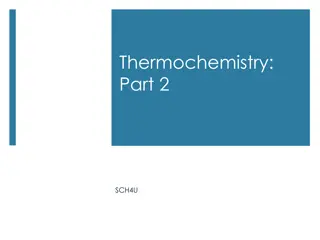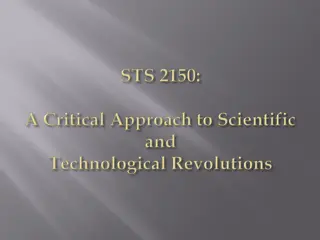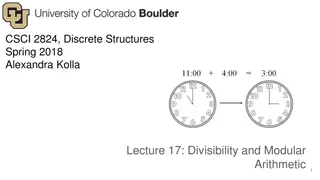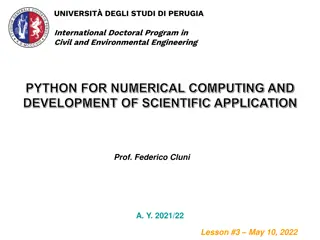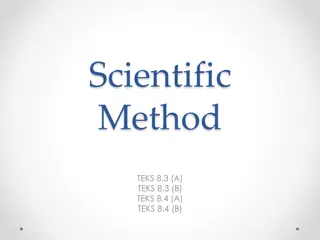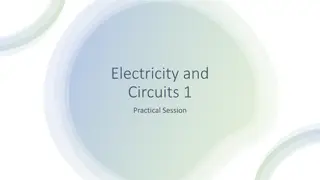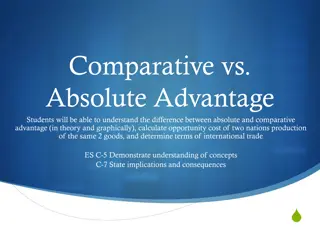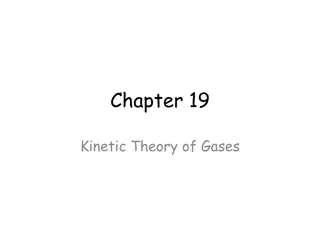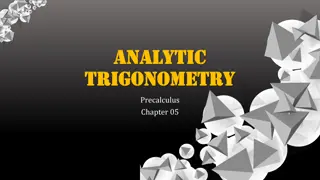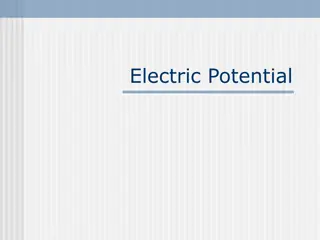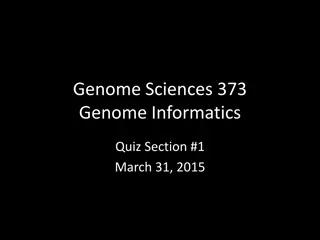Understanding Thermochemistry: Key Concepts and Examples
Energy is fundamental in thermochemistry, where we explore its conversion forms, such as potential and kinetic energy. State functions and chemical energy play crucial roles in exothermic and endothermic reactions, affecting stability and bonds. Dive into the world of energy transformations with practical examples and explanations.
Download Presentation

Please find below an Image/Link to download the presentation.
The content on the website is provided AS IS for your information and personal use only. It may not be sold, licensed, or shared on other websites without obtaining consent from the author. Download presentation by click this link. If you encounter any issues during the download, it is possible that the publisher has removed the file from their server.
E N D
Presentation Transcript
Chapter 6 - Thermochemistry DE Chemistry Dr. Walker
Terms To Know Energy The capacity to do work or to produce heat. Law of Conservation of Energy Energy can be converted from one form to another but can be neither created nor destroyed. Potential Energy Energy due to position or composition. Chemicals store potential energy in their bonds that can later be released at heat
Terms To Know Kinetic energy energy due to the motion of the object and depends on the mass of the object m and its velocity v Heat - The transfer of energy between two objects due to a temperature difference Work - Force acting over a distance
State Functions A state function refers to a property of the system that depends only on its present state. State functions do not depend on what has happened in the system, or what might happen in the system in the future State functions are independent of the pathway taken to get to that state.
Examples of State Functions Example Elevation Denver 5280 ft, Chicago 674 ft The difference is 4606 ft, no matter what route was taken between those cities. A liter of water behind a dam has the same potential energy for work regardless of whether it flowed downhill to the dam, or was taken uphill to the dam in a bucket. The potential energy is a state function dependent only on the current position of the water, not on how the water got there.
Chemical Energy Exothermic reactions Reactions that give off energy as they progress Some of the potential energy stored in the chemical bonds is converted to thermal energy (random KE) through heat Products are generally more stable (stronger bonds) than reactants
Energy Diagram of an Exothermic Reaction CH4 + 2 O2 2 H2O + CO2
Chemical Energy Endothermic reactions Reactions in which energy is absorbed from the surroundings Energy flows into the system to increase the potential energy of the system Products are generally less stable (weaker bonds) than the reactants
Exothermic Reaction Energy Diagram N2 + O2 2 NO
Thermodynamics The study of energy and its interconversions First Law of Thermodynamics The energy of the universe is constant
Internal Energy Total sum of all potential and kinetic energies in the system. The internal energy (E) of a system can be changed by a flow of work (w), heat (q), or both.
E = q + w E = change in internal energy of a system q = heat flowing into or out of the system -q if energy is leaving to the surroundings +q if energy is entering from the surroundings w = work done by, or on, the system -w if work is done by the system on the surroundings +w if work is done on the system by the surroundings
Example Calculate E for a system undergoing an endothermic process in which 15.6 kJ of heat flows and where 1.4 kJ of work is done on the system.
Example Calculate E for a system undergoing an endothermic process in which 15.6 kJ of heat flows and where 1.4 kJ of work is done on the system. q = -15.6 kJ w = + 1.4 kJ E = q + w E = - 15.6 kJ + 1.4 kJ = - 14.2 kJ
Work, Pressure, and Volume w P V = Compression Expansion + V (increase) - V (decrease) -w results +w results Esystemdecreases Esystemincreases Work has been done on the system by the surroundings Work has been done by the system on the surroundings
PV Work Example Calculate the work associated with the expansion of a gas from 46 L to 64 L at a constant external pressure of 15 atm.
PV Work Example Calculate the work associated with the expansion of a gas from 46 L to 64 L at a constant external pressure of 15 atm. W = -P V W = - (15 atm)(64 L 46 L) W = - 270 L.atm (this is an energy unit, just not joules) Negative work system is doing work on the surroundings with expansion
Example A balloon is being inflated to its full extent by heating the air inside it. In the final stages of this process, the volume of the balloon changes from 4.00 x 106 L to 4.50 x 106 L by the addition of 1.3 x 108 J of energy as heat. Assuming that the balloon expands against a constant pressure of 1.0 atm, calculate E for the process. (To convert between L atm and J, use 1 L atm = 101.3 J.)
Example A balloon is being inflated to its full extent by heating the air inside it. In the final stages of this process, the volume of the balloon changes from 4.00 x 106 L to 4.50 x 106 L by the addition of 1.3 x 108 J of energy as heat. Assuming that the balloon expands against a constant pressure of 1.0 atm, calculate E for the process. (To convert between L atm and J, use 1 L atm = 101.3 J.) E = q + W q = 1.3 x 108 J w = - (1.0 atm)(4.50 x 106 - 4.00 x 106 L) = 5.0 x 105 L atm W = - 5.0 x 105 L atm (101.3 J/L atm) = - 5.1 x 107 J E = 1.3 x 108 J + (- 5.1 x 107 J) = 8 X 107 J The heat addition (+q) overcomes the work done on the surroundings (-PV) to have a positive energy for the process
Energy Change in Chemical Processes Endothermic: Reactions in which energy flows into the system as the reaction proceeds. + qsystem - qsurroundings
Energy Change in Chemical Processes Exothermic: Reactions in which energy flows out of the system as the reaction proceeds. - qsystem + qsurroundings
Calorimetry The amount of heat absorbed or released during a physical or chemical change can be measured, usually by the change in temperature of a known quantity of water in a calorimeter.
Bomb Calorimetry Steel vessel capable of withstanding large pressures and exploding force (if necessary) of burning reagents. Container has constant volume = no work done, E = q
Units for Measuring Heat The Joule is the SI system unit for measuring heat: 1 1 newton Joule = 2 1 kg m = meter 2 s The calorie is the heat required to raise the temperature of 1 gram of water by 1 Celsius degree calorie 1 = . 4 18 Joules 1 BTU is the heat required to raise the temperature of 1 pound of water by 1 F
Specific Heat The amount of heat required to raise the temperature of one gram of substance by one degree Celsius. Substance Specific Heat (J/g K) 4.18 2.44 2.06 0.897 0.709 q = c . m . T Water (liquid) Ethanol (liquid) Water (solid) Aluminum (solid) Carbon (graphite,solid) Iron (solid) Copper (solid) Mercury (liquid) Lead (solid) Gold (solid) q = Heat lost or gained c = Specific Heat Capacity T = Temperature change m = mass 0.449 0.385 0.140 0.129 0.129
More on Heat and Terminology q = c . m . T Remember q is heat and heat is a form of energy heat = q H = enthalpy = energy (E) q = E at constant volume because no work is done (w = P V = 0) These are all interchangeable terms used in this chapter This applies to reaction coordinates, calorimetry, and specific heat capacity
Calorimetry Example When 1.00 L of 1.00 M Ba(NO3)2 solution at 25.0 C is mixed with 1.00 L of 1.00 M Na2SO4 solution at 25 C in a calorimeter, the white solid BaSO4 forms and the temperature of the mixture increases to 28.1 C. Assumptions: Calorimetry absorbs no heat (not true, we ll see in our lab) Specific heat of solution is 4.18 J/C g Density of solution is 1.0 g/mL, gives us mass = 2.0 x 103 g Calculate the enthalpy change per mole of BaSO4 formed.
Calorimetry Example q = c . m . T m = 2.0 x 103 g c = 4.18 J/C g T = 28.1 25 = 3.1 C q = (2.0 x 103 g)(4.18 J/C g)(3.1 C) = - 2.6 x 104 J Why is the sign negative? Temp goes up = exothermic reaction = energy loss by the system
A Second, Harder Example A 30.0-g sample of water at 280. K is mixed with 50.0 g of water at 330. K. Calculate the final temperature of the mixture assuming no heat loss to the surroundings. Specific heat of water = 4.18 J/g C
A Second, Harder Example A 30.0-g sample of water at 280. K is mixed with 50.0 g of water at 330. K. Calculate the final temperature of the mixture assuming no heat loss to the surroundings. Specific heat of water = 4.18 J/g C What to do: If there is no heat loss, the energy of the solutions is equal Set up specific heat equation for both equal sides Tf (final temp) is the unknown, plug in everything else and solve First solution s temp goes up, Second solution s temp goes down
A Second, Harder Example A 30.0-g sample of water at 280. K is mixed with 50.0 g of water at 330. K. Calculate the final temperature of the mixture assuming no heat loss to the surroundings. Specific heat of water = 4.18 J/g C q = c . m . T (solution 1) = c . m . T (solution 2) (4.18 J/g C)(30.0 g)(Tf 280 K) = (4.18 J/g C)(50.0 g)(330 Tf) (30.0Tf 8400) = (16500 50.0Tf) 80Tf = 24900 Tf = 311.25
Hesss Law In going from a particular set of reactants to a particular set of products, the change in enthalpy is the same whether the reaction takes place in one step or a series of steps. Enthalpy is a state function Only the overall change is important, not the pathway. = n H o f o f (products) (reactants) H n H reaction p r
Hesss Law Example Notice that whether the process occurred in one or two steps, the overall process took the same amount of energy overall
Enthalpy Changes with Hesss Law If a reaction is reversed the sign on H is reversed The magnitude of H is directly proportional to the quantities of reactants and products in a reaction. If the coefficients in a balanced reaction are multiplied by an integer, the value of H is multiplied by the same integer
Using Hesss Law Work backward from the final reaction Reverse reactions as needed, being sure to also reverse H Remember that identical substances found on both sides of the summed equation cancel each other
Hesss Law Example Calculate H for the combustion of methane, CH4: CH4 + 2O2 Reaction C + 2H2 C + O2 H2 + O2 CO2 + 2H2O Ho -74.80 kJ -393.50 kJ -285.83 kJ CH4 CO2 H2O
Hesss Law Example Calculate H for the combustion of methane, CH4: CH4 + 2O2 Reaction C + 2H2 C + O2 H2 + O2 CO2 + 2H2O Ho -74.80 kJ -393.50 kJ -285.83 kJ CH4 CO2 H2O CH4 C + 2H2 +74.80 kJ Step #1: CH4 must appear on the reactant side, so we reverse reaction #1 and change the sign on H.
Hesss Law Example Problem Calculate H for the combustion of methane, CH4: CH4 + 2O2 Reaction C + 2H2 C + O2 H2 + O2 CO2 + 2H2O Ho -74.80 kJ -393.50 kJ -285.83 kJ CH4 CO2 H2O CH4 CO2 -393.50 kJ C + 2H2 +74.80 kJ C + O2 Step #2: Keep reaction #2 unchanged, because CO2 belongs on the product side
Hesss Law Example Problem Calculate H for the combustion of methane, CH4: CH4 + 2O2 Reaction C + 2H2 C + O2 H2 + O2 CO2 + 2H2O Ho -74.80 kJ -393.50 kJ -285.83 kJ CH4 CO2 H2O CH4 C + O2 2H2 + O2 C + 2H2 CO2 -393.50 kJ 2 H2O -571.66 kJ +74.80 kJ Step #3: Multiply reaction #2 by 2
Hesss Law Example Problem Calculate H for the combustion of methane, CH4: CH4 + 2O2 Reaction C + 2H2 C + O2 H2 + O2 CO2 + 2H2O Ho -74.80 kJ -393.50 kJ -285.83 kJ CH4 CO2 H2O CH4 CO2 -393.50 kJ 2H2 + O2 2 H2O CH4 + 2O2 CO2 + 2H2O C + 2H2 +74.80 kJ C + O2 -571.66 kJ -890.36 kJ Step #4: Sum up reaction and H
Standard Enthalpy (Heat) of Formation The change in enthalpy that accompanies the formation of mole of a compound from its elements in their standard state
Calculation of Heat of Reaction from Enthalpies of Formation Calculate H for the combustion of methane, CH4: CH4 + 2O2 Hrxn = Hf(products) - Hf(reactants) Substance CO2 + 2H2O Hf CH4 O2 CO2 H2O -74.80 kJ 0 kJ Hf for elements = 0 -393.50 kJ -285.83 kJ
Calculation of Heat of Reaction from Enthalpies of Formation Calculate H for the combustion of methane, CH4: CH4 + 2O2 Hrxn = Hf(products) - Hf(reactants) Substance CO2 + 2H2O Hf CH4 O2 CO2 H2O -74.80 kJ 0 kJ Hf for elements = 0 -393.50 kJ -285.83 kJ Hrxn = [-393.50kJ + 2(-285.83kJ)] [-74.80kJ] Hrxn = -890.36 kJ
More Examples of Heat of Formation Calculate the standard change in enthalpy for the thermite reaction Hrxn = Hf(products) - Hf(reactants)
More Examples of Heat of Formation Calculate the standard change in enthalpy for the thermite reaction Hrxn = Hf(products) - Hf(reactants) (- 1676 kJ/mol) - (-826 kJ/mol) = - 850. kJ/mol
Heat of Reaction Example Give the heat of reaction for the combustion of gasoline, assuming it is pure octane (which it isn t) 2 C8H18 (l) + 25 O2 (g) 16 CO2 (g) + 18 H2O (g)
Heat of Reaction Example Give the heat of reaction for the combustion of gasoline, assuming it is pure octane (which it isn t) 2 C8H18 (l) + 25 O2 (g) 16 CO2 (g) + 18 H2O (g) Hf (products) = (16 moles x -394 kJ/mol) + (18 moles x -286 kJ/mole) = -11452 kJ Hf (reactants) = (2 moles x -269 kJ/mol) + (0) = -538 kJ Hf (products) - Hf (reactants) = -11452 kJ (-538 kJ) = - 10914 kJ -10914 kJ/ 2 moles = -5457 kJ/mole



